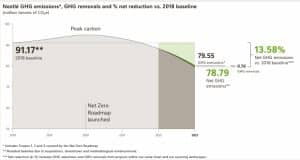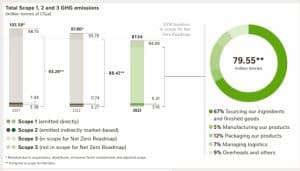For more than two decades, Nestlé through its “Sustainable Agriculture Initiative” (SAIN) has empowered farmers to adopt sustainable practices in coffee production. This time, the company is enhancing its Arabica variety supply chain to mitigate the carbon footprint of coffee production. So, what’s brewing in here? Let’s find out.
Introducing Arabica Star 4: Nestlé’s Sustainable and High-Yielding Coffee Variety
Nestlé has developed a new high-yielding Arabica coffee variety called Star 4 to strengthen its coffee supply chain. As global coffee demand is growing significantly, irrespective of climate changes, Nestlé has innovated its coffee variety with a reduced carbon footprint. The news release highlighted that the company was very concerned about the shrinking of Arabica cultivation areas due to climate change. Thus, this prompted Nestlé to leverage its agricultural expertise to overcome environmental concerns while ensuring a steady supply chain.
Nestlé’s team of scientists, technologists, and agronomists hail that the Star 4 is a “novel high-yielding Arabica variety” selected in Brazil. It is highly resilient and has a unique Brazilian coffee flavor.
Jeroen Dijkman, Head of Nestlé’s Institute of Agricultural Sciences remarked,
“Ensuring resilient coffee supply chains is crucial for future generations to enjoy exceptional coffee. Star 4, with its larger bean size and resistance to coffee leaf rust, demonstrates significantly higher yields compared to Brazil’s predominant local varieties, thereby reducing its environmental footprint.”
Notably, Marcelo Burity, Nestlé’s Head of Green Coffee Development has emphasized the importance of optimizing farming practices to minimize greenhouse gas (GHG) emissions associated with coffee cultivation. He added,
“Optimizing cultivation practices remains vital as they are the primary factor contributing to the environmental impact of a cup of coffee.”
Other Sustainable Coffee Varieties of Nestlé
In addition to Star 4, Nestlé has introduced Roubi 1 and 2, Robusta varieties in Mexico, showcasing its ongoing commitment to innovative solutions in coffee cultivation. In the year 2021, the company added a new generation of carbon coffee using non-GMO breeding techniques. These two Robusta coffee varieties increase yields to 50% per tree compared to standard varieties. They cause a 30% reduction in the carbon dioxide equivalent (CO2e) footprint of green coffee beans.
The basic idea of sustainable coffee production is to produce more coffee per unit of land, fertilizer, and energy input. Reducing the carbon footprint of green coffee beans is crucial, as they contribute significantly to the total CO2e emissions of a cup of coffee, ranging from 40% to 80%. Nestlé’s new Robusta varieties achieve up to a 30% reduction in CO2e, marking a substantial environmental breakthrough in coffee production.
Planting More Shade Trees
Various initiatives focus on integrating shade trees within farming systems. This approach particularly benefits crops like cocoa and coffee, which thrive under shaded conditions. By encouraging farmers to plant more shade trees, the initiative aims to shield these crops from heat stress and other environmental threats such as heavy rainfall. Moreover, shade trees play a pivotal role in improving water management, enhancing biodiversity, and sequestering carbon dioxide from the atmosphere, thus contributing significantly to emission reduction efforts.
Boosting Soil Health
A critical component of sustainable agriculture involves improving soil health to maximize land productivity. Nestlé has adopted many eco-friendly practices such as no-tillage, cover cropping, crop rotation, and organic fertilizers. Additionally, composting agricultural waste essentially fosters a robust carbon cycle for sustainable farming practices.
Agroforestry in Border Areas
Another important criterion is optimizing the surrounding areas of the main farmland. Some such practices involve restoring forests and peatlands and implementing strategic projects like windbreaks. These efforts mitigate carbon emissions and protect the biodiversity of that agricultural land.
Some other significant technological advancements to enhance cocoa and coffee supply chains and restore carbon sinks involve:
- farm-level assessments
- sustainability certifications
- satellite monitoring systems
- 100% renewable energy
Nestlé’s Emission Reduction Strategies
According to its current sustainability report, Nestlé achieved a 13.58% GHG emissions reduction in 2023 as compared to its 2018 baseline.
source: Nestlé
Nestlé has pledged to curb their emissions by 20% by 2025. By 2050, the organization aims to achieve net zero emissions by implementing regenerative agricultural practices. Furthermore, it is transitioning its logistics and operations to zero emissions. This ensures all facets of the organization contribute to environmental sustainability.
It will use high-quality natural climate solutions, benefiting communities and ecosystems to offset residual emissions. This approach balances environmental impact with societal well-being, supporting a sustainable future for all.
source: Nestlé
DID YOU KNOW?
Here’s a cool fact! Nestlé clinched the top spot for “coffee sustainability” in the 2023 Coffee Brew Index, as highlighted in the latest Coffee Barometer report. The accolade reflects Nestlé’s robust coffee sourcing strategy, which integrates social, environmental, and economic dimensions.
David Rennie, Head of Coffee Brands at Nestlé, emphasized,
“This recognition underscores our ongoing dedication to responsible coffee sourcing. Through initiatives like the Nescafé Plan and Nespresso AAA Sustainable Quality™ Program, we collaborate closely with coffee farmers to promote sustainable and inclusive farming practices. Our commitment remains steadfast in innovating and advancing coffee farming for the better.”
With these science-backed coffee varieties and a strategic focus on sustainability, Nestlé is sure to achieve its net zero goals. Until then, let’s wait for the moment to savor a fresh cuppa as it hits the stores.




